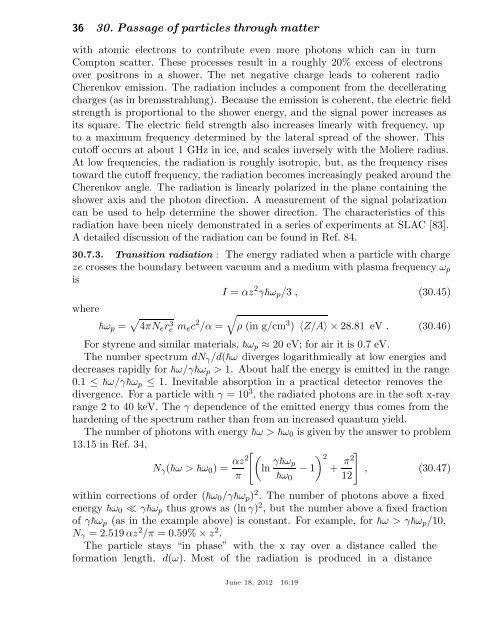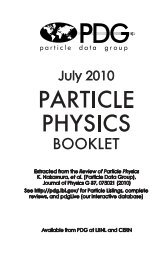30. Passage of particles through matter 1 - Particle Data Group
30. Passage of particles through matter 1 - Particle Data Group
30. Passage of particles through matter 1 - Particle Data Group
Create successful ePaper yourself
Turn your PDF publications into a flip-book with our unique Google optimized e-Paper software.
36 <strong>30.</strong> <strong>Passage</strong> <strong>of</strong> <strong>particles</strong> <strong>through</strong> <strong>matter</strong><br />
with atomic electrons to contribute even more photons which can in turn<br />
Compton scatter. These processes result in a roughly 20% excess <strong>of</strong> electrons<br />
over positrons in a shower. The net negative charge leads to coherent radio<br />
Cherenkov emission. The radiation includes a component from the decellerating<br />
charges (as in bremsstrahlung). Because the emission is coherent, the electric field<br />
strength is proportional to the shower energy, and the signal power increases as<br />
its square. The electric field strength also increases linearly with frequency, up<br />
to a maximum frequency determined by the lateral spread <strong>of</strong> the shower. This<br />
cut<strong>of</strong>f occurs at about 1 GHz in ice, and scales inversely with the Moliere radius.<br />
At low frequencies, the radiation is roughly isotropic, but, as the frequency rises<br />
toward the cut<strong>of</strong>f frequency, the radiation becomes increasingly peaked around the<br />
Cherenkov angle. The radiation is linearly polarized in the plane containing the<br />
shower axis and the photon direction. A measurement <strong>of</strong> the signal polarization<br />
can be used to help determine the shower direction. The characteristics <strong>of</strong> this<br />
radiation have been nicely demonstrated in a series <strong>of</strong> experiments at SLAC [83].<br />
A detailed discussion <strong>of</strong> the radiation can be found in Ref. 84.<br />
<strong>30.</strong>7.3. Transition radiation : The energy radiated when a particle with charge<br />
ze crosses the boundary between vacuum and a medium with plasma frequency ωp<br />
is<br />
I = αz 2 γ�ωp/3 , (<strong>30.</strong>45)<br />
where<br />
�ωp = � 4πNer 3 e mec 2 /α =<br />
�<br />
ρ (in g/cm 3 ) 〈Z/A〉 × 28.81 eV . (<strong>30.</strong>46)<br />
For styrene and similar materials, �ωp ≈ 20 eV; for air it is 0.7 eV.<br />
The number spectrum dNγ/d(�ω diverges logarithmically at low energies and<br />
decreases rapidly for �ω/γ�ωp > 1. About half the energy is emitted in the range<br />
0.1 ≤ �ω/γ�ωp ≤ 1. Inevitable absorption in a practical detector removes the<br />
divergence. For a particle with γ = 10 3 , the radiated photons are in the s<strong>of</strong>t x-ray<br />
range 2 to 40 keV. The γ dependence <strong>of</strong> the emitted energy thus comes from the<br />
hardening <strong>of</strong> the spectrum rather than from an increased quantum yield.<br />
The number <strong>of</strong> photons with energy �ω > �ω0 is given by the answer to problem<br />
13.15 in Ref. 34,<br />
Nγ(�ω > �ω0) = αz2<br />
�� ln<br />
π<br />
γ�ωp<br />
�ω0<br />
�2 − 1 + π2<br />
�<br />
12<br />
, (<strong>30.</strong>47)<br />
within corrections <strong>of</strong> order (�ω0/γ�ωp) 2 . The number <strong>of</strong> photons above a fixed<br />
energy �ω0 ≪ γ�ωp thus grows as (ln γ) 2 , but the number above a fixed fraction<br />
<strong>of</strong> γ�ωp (as in the example above) is constant. For example, for �ω > γ�ωp/10,<br />
Nγ = 2.519 αz 2 /π = 0.59% × z 2 .<br />
The particle stays “in phase” with the x ray over a distance called the<br />
formation length, d(ω). Most <strong>of</strong> the radiation is produced in a distance<br />
June 18, 2012 16:19







